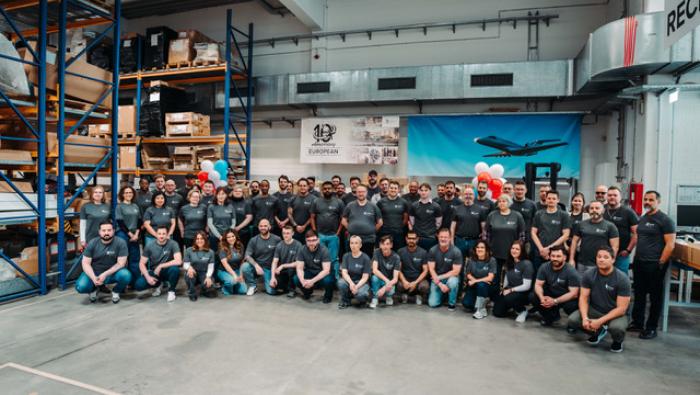Tamarack Aerospace has embarked on a program to develop and certify active winglets for the 200- and 300-series Beechcraft King Air turboprop twins, the company announced on Monday at NBAA-BACE. The Sandpoint, Idaho-based company is targeting military King Air fleets first and then will offer the modification to the civil market.
Although not at the official NBAA static display, Tamarack’s King Air 200 with the prototype winglet mod is at Las Vegas Henderson Executive Airport during NBAA-BACE this week, and the company is providing demo flights to highlight the performance improvements. After the show closes on Thursday, Tamarack will fly the King Air on a demonstration tour to prospective military customers.
The Tamarack King Air modification comprises winglets installed on the wingtips, wing extensions that helps improve performance, and the Tamarack active technology load alleviation system (Atlas) active camber surfaces (TACS), which automatically move during flight to relieve the added load on the wing due to the longer wing length and winglets. The TACS are driven by an actuator that is computer-controlled in response to load sensors and reacts almost instantly to changes in wing loading. Its active winglets eliminate the need to beef up, and thus add weight, to the wing structure to handle the increased load due to the winglets and added wingspan, with the result being more efficient flight and a reduction in turbulence effects.
Atlas winglets were previously certified for the Cessna CitationJet/CJ1/M2 through CJ3, which have one TACS on each winglet. About 150 Citations have been modified with Tamarack winglets so far. The winglet mod on the CJs enables climbing to higher initial altitudes and consequently improves fuel consumption by up to 33 percent.
In the King Air winglet mod—called Performance Smartwing—there will be two TACS per side, to improve dispatch rates. If one TACS fails, the other will enable the King Air to continue flying within certain speed limitations, although not as slowly as would be the case of failure of a single TACS when only one is installed. In the CitationJet, for example, a TACS failure requires slowing to 140 knots.
“Benefits that we’re seeing from the CitationJet will be amplified on the King Air,” said Tamarack president Jacob Klinginsmith. “It will look slightly different than the CJ winglet. The aerodynamic shape will be different since it’s optimized for a King Air. It’s going to be beneficial for a charter operator especially in terms of high-hot performance and utility, but also the military market is very interested in this modification because they have high-hot performance challenges, and also the loiter [capability] is going to be increased significantly. Some organizations we’ve talked to when we’ve shared projections said it changes their business model in a good way.”
The wing extension on the King Airs is significant, adding eight feet of wingspan on the King Air 200 and six feet on the King Air 350. According to Tamarack, the longer wingspan will have a big benefit for high-hot takeoff performance: “…the increased climb capabilities can allow aircraft to take off during conditions that otherwise would ground aircraft without the Tamarack Performance Smartwing modification. This benefit is crucial to the defense market, as mission readiness and safety are top priorities.”
For the 200 program, Tamarack did flight testing to establish baseline performance, then after the modification flew for three weeks to gather data, which it was still processing before the show. The company is working on obtaining a King Air 350 to modify and will then put that through the same process.
The first supplemental type certificate for Smartwing will be for the King Air 350. This should be granted by the end of 2022, followed by the King Air 200 mod.
For Tamarack, the benefit of its winglets is not just enabling customers to fly longer trips without stopping, but the sustainability features. While a lot of effort is underway to develop electric- and hydrogen-powered aircraft, Klinginsmith said, “Tamarack has a product available now. Traditional winglets have been proving that for many years, and this is the next generation of winglet. We have the biggest single sustainability upgrade now, and we’re happy to see it starting to get recognition in the aviation sustainability community.”
Klinginsmith pointed out that no matter how an aircraft is powered, “Our technology works well with sustainable aviation fuel (SAF) or electric or hybrid propulsion. We’re focused on reducing drag on the airframe, and others are focused on propulsion. We all have to work together.”
Tamarack would welcome the opportunity to work with manufacturers to design active winglets for new aircraft. “We’re open to collaborating with OEMs,” he said. “The technology works with existing airframes and clean-sheet designs. We have almost 30 patents, and we’re excited about opportunities with OEMs. That was our business plan from the beginning. Tamarack is a technology and sustainability company, starting with business jets, then [eventually] regional and single-aisle airliners.
“Implementing new Tamarack sustainable technologies like the Performance Smartwing into different aviation sectors is a positive step toward sustainability efforts,” he added. “As we move toward our big carbon emission reduction goals, we need to be looking at technologies that are going to make a significant impact and can be applied now while providing impactful operational cost savings.”







